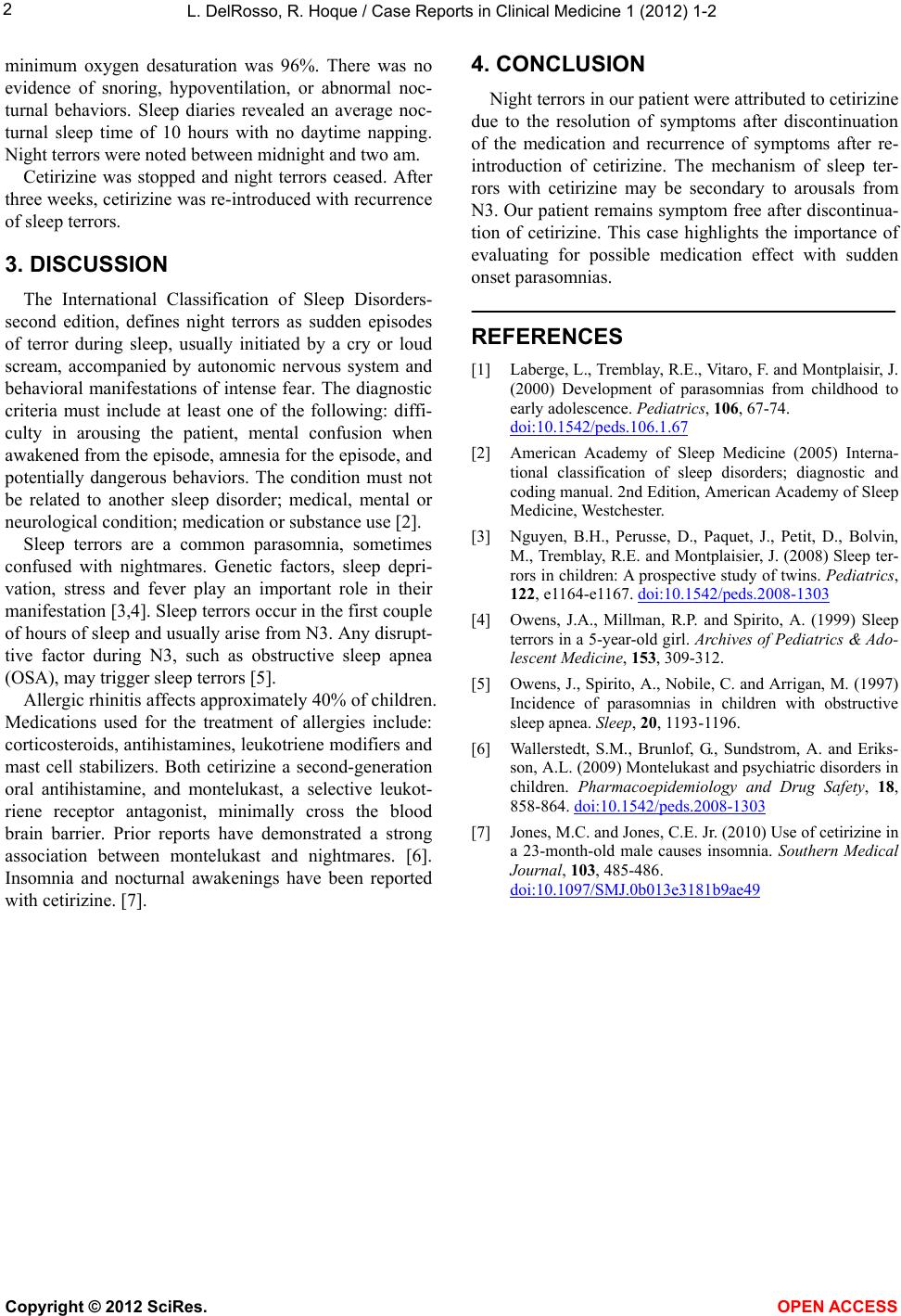
L. DelRosso, R. Hoque / Case Reports in Clin ical Medicine 1 (2012) 1-2
2
minimum oxygen desaturation was 96%. There was no
evidence of snoring, hypoventilation, or abnormal noc-
turnal behaviors. Sleep diaries revealed an average noc-
turnal sleep time of 10 hours with no daytime napping.
Night terrors were noted between midnight and two am.
Cetirizine was stopped and night terrors ceased. After
three weeks, cetirizine was re-introduced with recurrence
of sleep terrors.
3. DISCUSSION
The International Classification of Sleep Disorders-
second edition, defines night terrors as sudden episodes
of terror during sleep, usually initiated by a cry or loud
scream, accompanied by autonomic nervous system and
behavioral manifestations of intense fear. The diagnostic
criteria must include at least one of the following: diffi-
culty in arousing the patient, mental confusion when
awakened from the episode, amnesia for the episode, and
potentially dangerous behaviors. The condition must not
be related to another sleep disorder; medical, mental or
neurological condition; medication or substance use [2].
Sleep terrors are a common parasomnia, sometimes
confused with nightmares. Genetic factors, sleep depri-
vation, stress and fever play an important role in their
manifestation [3,4]. Sleep terrors occur in the first couple
of hours of sleep and usually arise from N3. Any disrupt-
tive factor during N3, such as obstructive sleep apnea
(OSA), may trigger sleep terrors [5].
Allergic rhinitis affects approx imately 40% o f child ren.
Medications used for the treatment of allergies include:
corticosteroids, antihistamines, leu kotriene modifiers and
mast cell stabilizers. Both cetirizine a second-generation
oral antihistamine, and montelukast, a selective leukot-
riene receptor antagonist, minimally cross the blood
brain barrier. Prior reports have demonstrated a strong
association between montelukast and nightmares. [6].
Insomnia and nocturnal awakenings have been reported
with cetirizine. [7].
4. CONCLUSION
Night terrors in our patient were attributed to cetirizine
due to the resolution of symptoms after discontinuation
of the medication and recurrence of symptoms after re-
introduction of cetirizine. The mechanism of sleep ter-
rors with cetirizine may be secondary to arousals from
N3. Our patient remains symptom free after discontinua-
tion of cetirizine. This case highlights the importance of
evaluating for possible medication effect with sudden
onset parasomnias.
REFERENCES
[1] Laberge, L., Tremblay, R.E ., Vitaro, F. and Montplaisir, J.
(2000) Development of parasomnias from childhood to
early adolescen ce. Pediatrics, 106, 67-74.
doi:10.1542/peds.106.1.67
[2] American Academy of Sleep Medicine (2005) Interna-
tional classification of sleep disorders; diagnostic and
coding manual. 2nd Edition, American Academy of Sleep
Medicine, Westchester.
[3] Nguyen, B.H., Perusse, D., Paquet, J., Petit, D., Bolvin,
M., Tremblay, R.E. and Montplaisier, J. (2008) Sleep ter-
rors in children: A prospective study of twins. Pediatrics,
122, e1164-e1167. doi:10.1542/peds.2008-1303
[4] Owens, J.A., Millman, R.P. and Spirito, A. (1999) Sleep
terrors in a 5-year-old girl. Archives of Pediatrics & Ado-
lescent Medicine, 153, 309-312.
[5] Owens, J., Spirito, A., Nobile, C. and Arrigan, M. (1997)
Incidence of parasomnias in children with obstructive
sleep apnea. Sleep, 20, 1193-1196.
[6] Wallerstedt, S.M., Brunlof, G., Sundstrom, A. and Eriks-
son, A.L. (2009) Montelukast and psychiatric disorders in
children. Pharmacoepidemiology and Drug Safety, 18,
858-864. doi:10.1542/peds.2008-1303
[7] Jones, M.C. and Jones, C.E. Jr. (2010) Use of cetirizine in
a 23-month-old male causes insomnia. Southern Medical
Journal, 103, 485-486.
doi:10.1097/SMJ.0b013e3181b9ae49
Copyright © 2012 SciRes. OPEN ACCESS